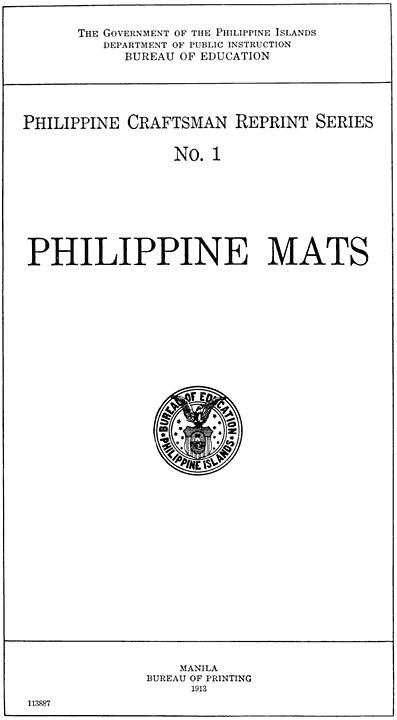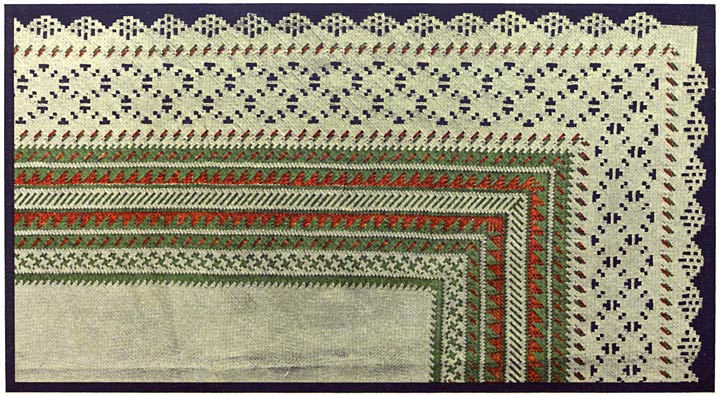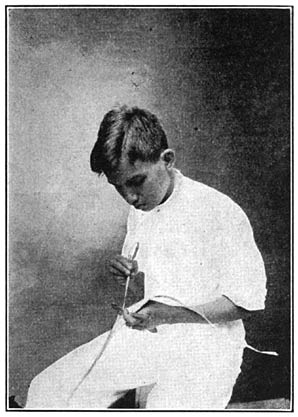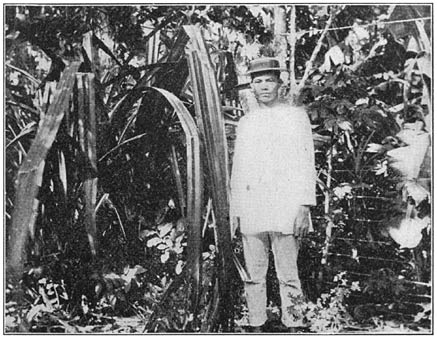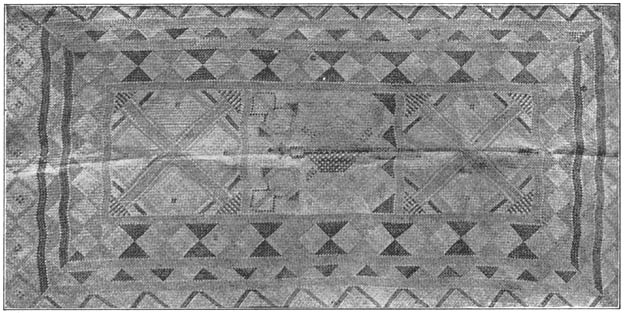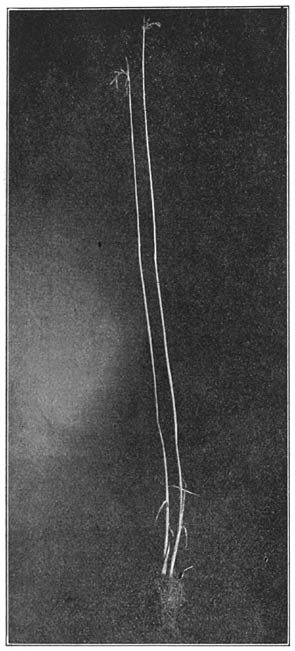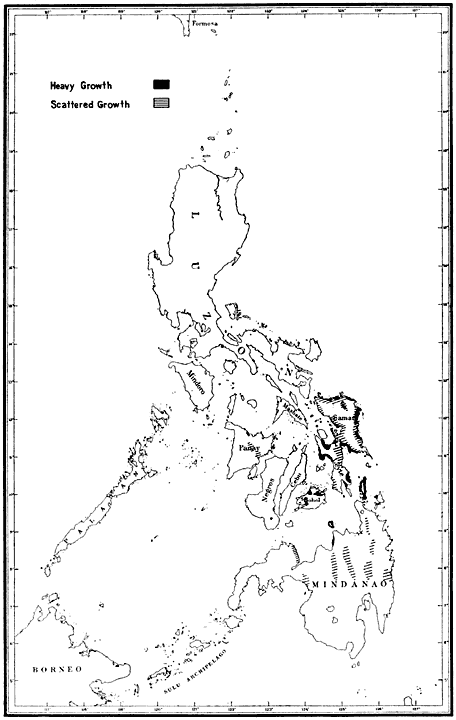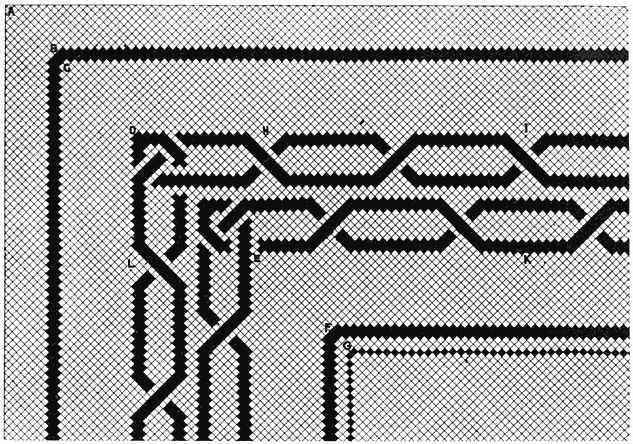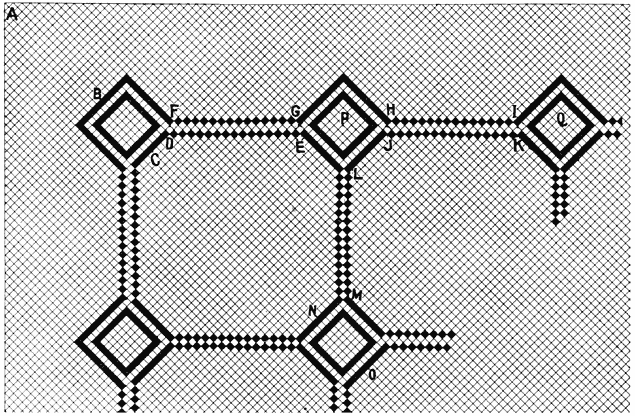[Contents]
Kinds of Weaves.
With respect to their weaving, Philippine mats divide themselves
into six groups and are here arranged according to their difficulty.
They are (1) the over and under weave found in most simple mats, such
as those made of buri straws, pandan straws, and sedges; (2) the sawali
weaves, which employ the floating straws for making “woven
in” designs and panels for figured sabutan and tikug mats; (3)
the open work weaves of the Romblon buri mats; (4) the circular mats
which employ the hat weaves, either with or without “woven
in” designs; (5) the hexagonal weave; and (6) the embroidered
mats in which the designs are later added. In difficulty, and in place
in a course of instruction, embroidered mats follow the simple over and
under weave. [21]
[22]
[23]
[24]
[Contents]
Over-and-Under Weave.
This weave is the simplest and is the one which beginners should
first take up. It is made by weaving over one and under one
continuously. Until this is thoroughly mastered children should not be
allowed to begin the more difficult weaves.
The steps have been diagrammed in figures sufficiently large and
clear in Plates VII, VIII, and
IX that a detailed explanation is not necessary.
Step 1 shows the position of the first four straws as they are placed
upon the table or desk; steps 2, 3, 4, and 5, continued additions and
weaving; steps 6, 7, and 8, turning the edge a on the end of the
mat; step 9, turning the opposite edge c; step 10, the double
turn of the corner straw; step 11, the corner turn woven in the mat at
corner No. 1, lapping over the straw already woven; step 12, the
continuation of the second edge b; step 13, the turning of the
second and third corners; and steps 14 and 15, finishing the mat.
In weaving large mats, it is customary to begin at one end of the
mat, preferably near the left-hand corner as the mat lies before the
weaver. The weaving continues along the end until half of the desired
width of the mat is reached, when the first corner is turned. Now the
weaving continues down the side and in, as far as the middle of the
mat. When the desired length is woven, the second corner is turned and
the first half of the mat completed.
As the straws are not generally long enough without splicing, new
straws are now added by lapping them from two to three inches upon the
projecting ends of the straws already woven. This makes a narrow strip
of double thickness down the center running the length of the mat. The
weaving now continues as before until the desired width of the mat is
attained, when the third corner is turned. The remainder is woven and
finished at the fourth corner as shown by steps 14 and 15.
Some weavers begin at the sides, and some few, even at the corners;
but this should not be encouraged since it results in making two or
more seams, where the straws lap.
Care must be taken to weave all parts of the mat equally close and
keep the edges perfectly straight; otherwise the mat when finished will
be lop-sided, and consequently of no value. In weaving tapering grasses
like tikug, which have ends of slightly different sizes, the opposite
ends of the straws should be alternated. This prevents one edge of a
mat from building faster than the other. [25]
[26]
[27]
[Contents]
Sawali Weaves.
Simple Sawali.
By sawali weave is meant all “woven in” designs that are
not woven by ones as in the over and under weave. They may be
woven regularly by twos, threes, etc.; or they may
“switch” the floating straws so as to form a variety of
artistic figure designs. In fact, there is no limit to the number of
designs that may be thus made.
Steps 1 and 2 illustrate the beginning of a sawali weave by
twos. First 1, 2, 3, 4, 5 are laid down; then c is put
under 1–2, over 3–4, and under 5; d over 1, under
2–3, and over 4–5; e over 1–2, under
3–4, and over 5. This process is continued, advancing one straw
each time until the desired amount is woven. If the weaving is by
threes or fours, the same principle is followed; that is,
the straw goes over three and under three, advancing one straw each
time.
Panels.
Most “woven in” mat designs are arranged in panels, with
a ground between, as this gives a more pleasing effect than a
continuous figure weaving. Panels may be woven either length-wise (step
8), crosswise (step 8), diagonally across the mat (step 4), or in
zigzags (step 3). They are most easily woven when arranged diagonally,
for then the colors may be carried from border to border without mixing
with the ground outside of the panel. Checks are made by weaving cross
panels at regular intervals.
In making parallel panels (panels parallel either to the sides or
ends), more than two colors can rarely be used to advantage.
Step 3 illustrates the weaving of a zigzag sawali panel. The straws,
a, b, k, and l are woven by ones. It
takes twelve straws one way and nine the other to make this panel. If a
wider panel is desired, the same weaving is repeated as often as
necessary.
The straws a, b, k, and l are woven by
ones. Put l over b and c, under de,
over fg, under hi and over j. Put 2 under
b, over cd, under ef, over gh, under
ij and over k. Put 3 over b, under c, over
de, under fg, over hi and under jk. Put 4
under bcd, over ef, under gh and over ijk.
Put 5 over bc, under de, over fg, under hi
and over j. Put 6 under b, over cd, under
ef, over gh, under ij and over k. Put 7
over b, under c, over de, under fg, over
hi, under jk. Put 8 under b, over cd, under
ef, over gh, under ij and over k. Put 9
over bc, under de, over [29]fg, under
hi and over j. Put 10 under bcd, over ef,
under gh and over ijk. Put 11 over b, under
c, over de, under fg, over hi and under
jk. Put 12 under b, over cd, under ef, over
gh, under ij and over k. Then the whole operation
is again repeated. It will be seen that the manner of weaving 2 and 12,
3 and 11, 4 and 10, and 5 and 9 is the same.
Step 4 illustrates the diamond figure design, woven by threes, with
11 straws in width.
Put 1 under cd, over efg, under h, over
ijk and under lm. Put 2 under c, over def,
under ghi, over jkl and under m. Put 3 over
cde, under fghij and over klm. Put 4 over
cd, under efg, over h, under ijk and over
lm. Put 5 over c, under def, over ghi,
under jkl and over m. Put 6 under cde, over
fghij and under klm. Now the order reverses, 7 being the
same as 5, 8 as 4, etc., until the other half of the figure is
completed at 11. Now put 12 under cde, over fghij and
under klm. Put 13 over c, under def, over
ghi, under jkl and over m. Put 14 under
cde, over fghij and under klm. Now 1 repeats
itself, and the second figure is woven as the first. It is believed
that with the aid of the large illustrations here presented the teacher
or pupil can now follow for himself the other designs given, without a
detailed explanation of each step. [30]
“Woven-in” Borders.
Woven-in border designs may be made in three different ways; viz.,
First, by weaving the design around the mat, using the same
straws that run through the body. (See Plate
XIII, Fig. 1.) In this case the color effect is one of confusion,
since the dyed straws used in the designs of the body of the mat have
no relation to the design of the border when they enter it.
Second, by weaving the border and the body of the mat of
different straws, uniting them at the inner edge of the border by a
loop as described in the Romblon mat. (See Plate
XVI.) Third, by lapping the colored straws desired in the
border, upon the projecting ends of the straws of the body of the mat.
(See step 8, Plate XII.) These latter two methods
are much more artistic, as a uniform color effect appears throughout
the border. (See Plate XIII, Fig. 2.)
[Contents]
The Romblon Mat.
Making Open Work.
Simple open work is illustrated in Plate
XIV.
Weave corner Z, using straws a, b, c, d, e and f,
letting f float at both ends. Weave g, turning upward and
over f, then making a double corner at y, passing under
f, to the left and over f, and [31]let
float. Weave h, i, j, k, l and
m in solid weave. Turn h under i and over
j. Turn j upward and over i, to the left under
f, upward over g, double corner at W, passing down under
g, over g, and floating. Turn m upward over
l to the left, under i, upward over f, to the left
under g, upward over j making a double corner at X,
passing under j. The straws j and m alternately
cross each other to corner V.
The other half of this open design is an exact duplicate of this
weaving, and the remaining designs have the same turns as the one
explained, except that in opposite designs the straws are turned in
opposite directions. By following this plate it is easy to finish the
weaves. If one straw is woven over another, it folds down before
passing over, and, vice versa, if it passes under, it folds upward in
turning.
As is seen, the holes are made simply by turning the straws in the
weave. The different shaped holes in other designs (see plates) are
made by turning a different number of straws according to the shape
desired. Varied border edges may be made by switching the straws in any
direction desired. [32]
[33]
Introducing Color Panel.
Step 1 of Plate XVI shows the first colored
panel, straw ab placed between cd, the space between
x and y having been already woven, as shown in step
11.
Step 2. Folding a to the right.
Step 3. Folding a under and down.
Step 4. Folding c over a and to left.
Step 5. Folding a over c and upward.
Step 6. Folding b under d to left.
Step 7. Folding b upward, with right twist downward.
Step 8. Folding d downward, with right twist to right.
Step 9. Folding b under d upward.
Step 10. Shows addition of second straw ef woven to the
right, where the same process of turning is gone through as illustrated
in steps 6 to 9 inclusive. If weaving is to the left, steps 1 to 5
inclusive are repeated.
Step 11. Shows continued additions and weaving both to the right and
left.
Step 12. Shows both edges of panel woven, the inside turnings being
the same as those of the outer edge.
[Contents]
Circular Mats.
The circular mat is woven like the crown of a hat, with either the
radiating center or a square center radiating at the four corners. In
either case, the weaver must be careful to add the proper number of
straws so that the mat will be flat, and not cupped or fluted. The
cupping is caused by not adding a sufficient number and the fluting by
adding too many.
In tightening the weaving, do not pull the added straws (Plate XIX, step 6, straw x-x) or holes will be made at the
elbow. Instead, pull the longer straws that run through the center,
thus making the entire weaving tight.
Radiating Center.
Step 1. Begin by laying down, in pairs, ab and cd
perpendicular to the body. Put kl under ab and over
cd. Put ij over ab and under cd.
Step 2. Now put ef under cd and ij, and over
ab and kl; then put gh over cd and
ij, and under kl and ab. See that the two ends of
all the straws are equidistant from the center crossing.
In step 3 the straws are changed from pairs to singles as follows:
Bring a over i; e over d; i over
h; d over l; h over a; and l
over e. [34]
[35]
[36]
[37]
[38]
[39]
Step 4. The most convenient way to perform the next process is to
take all the bottom straws in the left hand and allow the top straws to
float over the closed fist. Then the weaving is done with the right
hand. However, for beginners the weaving may also be done on the
table.
In weaving, place c under b, over a and under
k; d over b and under a; g under
f, over e and under b; h over f and
under e; k under j, over i and under
f; l over j and under i; b under
c, over d and under a; a over c and
under d; f under g, over h and under
c; e over g and under h; j under
k, over l and under g; i over k and
under l; the round is then finished.
Step 5. This illustrates the manner of adding straws. Straw x
is placed under c, over h, under g and then bent
back. The bend should be in the middle of the straw.
Step 6. In this the right end of the added straw x is brought
down over j and under i.
Step 7 shows how to continue the additions by weaving one straw and
then adding one.
Step 8 shows the mat after the first round of additions has been
completed. The weaving is now easy. Weave entirely around again without
any additions, turning five straws each time. Then go around again
weaving two and adding one, in the same manner as before, turning seven
straws each time. As the diameter of the mat increases, the less often
is it necessary to add. But be sure to add enough to keep the weaving
close and the mat perfectly flat.
Step 9 shows how to close the edge of the mat by turning back the
straws on each other. It also gives a very pretty “woven
in” design for a border, which can easily be followed from the
plate.
Square Center.
Steps for commencing a circular mat with a square beginning are
illustrated in Plate XXI. The additions at the
corner are made in the same manner as explained in the radiating
center, except that each is for a fourth of a circle instead of a
complete circle.
Decorations for Round Mats.
Decorations are often employed in round mats. (See Plates XXII and XXIII.) The most usual are
concentric or radiating colored bands of either simple or sawali
weaves.
[Contents]
Hexagonal Weave.
Step 1. In Plate XXIV, place straws 1 and 2
parallel; then put 3 under 2 and over 1; put 4 under 1 and over 2.
[40]
[41]
[42]
Step 2. Put 5 over 1 and 4 and under 2 and 3; put 6 under 1 and 4
and over 2 and 3.
Step 3. Put a over 5 and 6 and under 1 and 2. Put b
over 1, 2 and a, and under 3 and 4. Put c under a,
over 4, 3, b, and under 6, 5.
Step 4. Put d under b, over 6, 5, c, and under
2, 1, e. Put e under c, over 2, 1, d, under
3, 4, and over a. Put f under d, over 3, 4,
e, under 5, 6, a, and over b.
Step 5 is made open so as to show the triple over and under weave.
Further weaving is merely a repetition of this process, as shown in
step 6.
[43]
[44]
Step 7 shows the turning of the straws on finishing the edge of the
mat.
Step 8. Many designs can be made by inserting colored straws into
the natural weave. Step 8 illustrates three of these embroidered
designs—the star, the bar, and the diamond.
[Contents]
Embroidered Mats.
The embroidering of mats is easily done and the method is shown in
Plate XXVI. Mats in over and under weave, of solid
color (either natural or dyed), are used, and the embroidery is done
with colored straws. Plate XXVII illustrates an
embroidered color panel. Floral, geometrical, and conventionalized
designs are discussed under the headings “Samar mats” and
“Special designs.”
[Contents]
Embroidered Mat Designs.1
It is better not to decorate a mat at all than to have the design
ill fitting. Design is the pleasing arrangement of all spaces unfilled
as well as filled. Decoration is for beauty wholly. If all the spaces
are not well arranged, the design is not beautiful. If the design is
startling or gaudy in color, it is not beautiful. If the arrangement of
colors is inharmonious, the design is not beautiful. All mats cannot be
in the same proportion and suitable for all designs. Plate LXV, for instance, shows a long design; it requires a
long mat, and would not look well on a square one.
All mats here considered are about ⅛ inch to ¼ inch in
width of straw. Some of the designs are used exactly as they are,
counting a straw for a square which represents a straw in the design;
the others are double in size and contain four times as many squares in
the weave as in the design. In such cases twice the count of the design
will always give the right number for the weave.
In circular mats the directions are given in inches. The sizes of
the mats should be taken into consideration, but a variance of a few
inches will not matter if that variance always makes the mat larger
rather than smaller. In these mats more is left to the judgment of the
weaver than in rectangular mats. Designs should never be crowded on
circular mats. Repeated groups should always be made exactly alike.
In the color notes, a series of colors set off by commas indicates
that each series may be used alone for the whole design. Often the deep
colors, especially No. 1, have been left out, as the effect of a very
dark color on a very light mat is often startling. Designs on mats or
hangings should not be more conspicuous than the mat itself, but should
rather present a complete and harmonious appearance when both mat and
design are considered as a whole. [106]
[Contents]
Circular Mats.
Design A.
The straws of a circular mat cannot be counted and then divided
equally by numbers, as straws are continually added at irregular
intervals as the circumference is being reached. Hence, the only way to
place designs on a mat of this kind is by dividing the whole mat with a
diameter through its center.
Fold the mat and make a crease at the edges or mark a diameter
through it with a pencil; at right angles to this diameter draw another
through the same center, and the mat will now be divided into equal
quadrants. The quadrants may again be divided and subdivided, and
marked by pencil or with strings.
In Design A the mat is about 57 inches in diameter. In a mat of this
size there would be 48 units in the circle with a margin of 1½
inches from the outer edge of the outer border line to the
circumference of the mat. Divide the mat into halves, quarters,
eighths, and sixteenths, and measure with strings. Each sixteenth
contains three units. Divide this space into three equal parts.
[107]
Now embroider in each third one exact unit. In weaving in the unit,
always commence on its outer edge; then if any slight variation of
space has occurred, the irregularity will not be noticeable, as it will
be in the line work of the unit, and not in its solid part. Each unit
made in working as suggested from the outer edge inward will begin the
other half of a solid figure already commenced. Notice the part of the
design which has been marked off as one unit, and adhere to that
arrangement.
This design may be placed on a mat 57 inches in diameter, or 114
inches in diameter making each figure with twice as many straws as in
the first.
In ticug mats of natural straw, this design may be done in the
following colors:
No. 2, 3, 6, 9, 10, 12, 15, or 16. (12 and 16 should not be used on
sabutan.)
No. 14, with a solid diamond and outer border line in No. 3.
No. 3, 6, 9, or 10, with outer border line extending to edge of
mat.
Design B.
In Design B, the mat should be 56 inches in diameter. In each
sixteenth of the mat, as in Design A, three units can be spaced. Note
the unit marked off in the design and use only this unit; weave its two
outer solid parts first, with the irregularities of space occurring in
the open part of the unit.2
Mats woven for this design should be 56 or 112 inches in diameter.
In mats of the latter size the numbers of straws are all doubled.
In mats of natural straw, the following colors may be used:
No. 2, 3, 6, 10, 15, or 16. (16 should not be used on sabutan.)
[Contents]
Circular Fish Design.
This design calls for the division of a circular mat into sixths or
twelfths, according to the size of the mat. The diameters of mats for
this design may be, 244 (about 4 feet); 304 (5 feet); 335 (6 feet); and
366 straws (7 feet). To divide a circle into sixths, mark off the
circumference into distances equal to ½ of the diameter.
In a mat of 244 straws diameter, make the outside border line one
inch from the edges of the mat. About 9 inches inside of the outer
border line, weave another border line one-half inch [108]wide. Midway between these two border lines,
measure and mark the space for the center fish, making it 30 counts
long, 20 on the left and 10 on the right of the dividing line.
Measure spaces on the other five dividing lines to locate the
central fish of each group. After weaving these central fish, go back
to the first group, estimate and mark the place for the upper fish and
the lower fish, and weave them, making each of the same size and
proportion as the central fish, as shown in the design.
In mat 304, as noted above, the border lines and all the fish are
the same size as in mat 244.
In mat 335 all measurements are the same as in the above mats,
except that the circle is divided into twelfths instead of sixths,
making twice as many groups of fish.
In mat 366 the outer border line is 2 inches from the edge of the
mat instead of 1 inch and is 1½ inches thick. The other
measurements are the same as in mat 335.
In mats of natural straw, the following colors may be used: No. 2,
3, 6, 10, 12, or 15. (12 should not be used on sabutan.)
[Contents]
Gecko Design.
Mats woven for this design should be of the following diameters: 304
(5 feet); 335 (6 feet); 366 straws (7 feet).
Divide the circle into sixths, then into twelfths. Weave a border
band on the edge of the mat ¾ inch wide. This band is not in the
design but will come outside, and reach to the circumference line in
the design. Down one of the twelve dividing lines, inside the border
band, measure off 3½ inches and [110]weave a gecko, half
on one side and half on the other side of the line, extending the tail
about 5½ inches toward the center of the mat. Weave the two on
each side of this gecko, and the four above it. Now space and weave the
other five groups. Each group contains seven figures.
The only difference in the larger mats will be in the spacing
between the tails. The groups should be spaced the same as before.
In ticug mats of natural straw, the following colors may be
used:
No. 1 with band of No. 3.
No. 1 with band of No. 9.
No. 12 with band of No. 15. (No. 3 should not be used on
sabutan.)
No. (singly) 2, 3, 6, 9, 10, or 15.
[Contents]
Geometric Design F.
The distance from A (the corner of the mat) to B is 12 straws;
from B to C is 2;
from C to D is 18;
from D to E is 29;
from D to H is 16;
from H to I is 32;
from E to F is 19; and
from F to G is 5.
Count from A to B. Weave from B to C and on around the entire
mat.
Count from C to D and weave corner D H J E L. Weave all of the four
corner designs exactly like D H J E L. Count from E to F and weave the
two inner border lines around the entire mat.
Now count from H to I and mark similar points across one side. Weave
from H to I. Weave from I to the next point (32 counts distant) the
exact design between H and I. Weave at each point marked. Complete all
four sides in a similar manner.
Mats woven for this design should be made in the following
sizes:
310 by 534—from A to B is 34 straws;
266 by 394—from A to B is 22;
512 by 704—from A to B is 12;
320 by 512—from A to B is 12 (double count);
320 by 576—from A to B is 12 (double count).
In the last two sizes make the design twice as large as the
[111]count; that is, A B should be 24, B C should be
4, C D should be 36, etc.
In mats of natural color straw, the following colors may be
used:
No. 2, 3, 6, 9, 10, 12, 15, or 16, each alone. (12 and 16 should not
be used on sabutan.) [112]
[Contents]
Geometric Design V.
The distance from the corner of the mat A to B is 22 straws;
from B to C is 12;
from C to D is 4;
from D to F is 2;
from D to E is 15;
from F to G is 15;
from L to M is 14;
from C to N is 38;
from N to O is 12;
from F to P is 20; and
from P to Q is 25.
Count from A to B. At B weave the corner double square and continue
on at FD to GE. Now weave the double square G H J E. Next weave the
double squares in all four corners of the mat.
Now count from P to Q and mark. In the same way mark all the centers
of the squares along the outer border line from corner to corner. Weave
these squares, then the lines joining them. Weave down from L to M and
continue the design on the inner border line, making double lines like
L M as the weaving progresses.
Mats woven for this design should be of the following sizes:
228 by 378—from A to B is 22 straws;
253 by 403—from A to B is 22 straws;
311 by 536—from A to B is 30 straws;
536 by 686—from A to B is 30 straws.
In straw mats of natural color, the following colors may be used:
No. 2, 3, 6, 10, or 15.
[Contents]
Geometric Design X.
The distance from A (corner of mat) to B is 22 straws (counting the
fold at A);
from B to C is 8;
from C to D is 5;
from D to E is 4;
from E to F is 20;
from F to G is 4;
from G to H is 3;
from H to I is 6; and
from J to L is 52.
Count from A to B and weave border line around the entire
[114]mat. Count from B to C and weave C D and over to
J, back to H, over to K and back to C. Weave inner part of corner
design. Weave inner border line at I entirely around the mat. Weave all
four corner designs. Mark off J L, and L M, and M N, etc., until the
corner is reached, making L M, M N, etc., each equal to J L. Weave all
designs on side now spaced off. Space off and mark each side of the
mat, before weaving. Weave all sides, completing the mat.
Mats woven for this design should be in the following sizes:
269 by 425;
321 by 529;
425 by 685;
165 by 425.
In mats of uncolored straw, the following colors may be used:
No. 2, 3, 6, 9, 12, 15, or 16. (12 and 16 should not be used on
sabutan.)
[Contents]
Geometric Design Z.
The distance from the corner A to B is 12 straws;
from B to C is 3;
from C to D is 16;
from D to E is 8;
from E to F is 26;
from F to G is 17;
from G to H is 4;
from D to K is 17;
from K to L is 12;
from L to M is 17; and
from I to J is 29.
Count down from A to B and weave the border lines B C around the
entire mat. Count from C to D and weave the outer square of the corner
figure. Complete the corner figure to I and N. Count from F to G and
weave G H around the entire mat. Complete all four corner designs.
Count from I to J and mark. From J count a distance equal to I J and
mark. Make similar marks until the corner is reached. Weave the design
I L M J between all these marks. Space off each side of the mat in the
same way and finish the design on all sides.
Mats woven for this design should be of the following sizes:
309 by 541—from A to B is 12 straws;
319 by 551—from A to B is 22 straws;
280 by 454—from A to B is 12 straws;
551 by 696—from A to B is 22 straws. [115]
On mats of uncolored straw, the following colors may be used:
No. 2, 3, 6, 9, 10, 15, or 16. (16 should not be used on
sabutan.)
No. 14 for border lines and the four large spots in the side of each
square; No. 3 for the remainder of the design.
No. 12 with spots and border lines of No. 3.
[Contents]
Large Banca Design.3
Distance from corner A to B is 41 straws;
from B to C, 2;
from B to G, 31;
from G to S, 5;
from C to D, 35;
from D to E, 2; and
from D to F, 10.
Begin weaving at letter B and weave the outer border line around the
entire mat. Next weave the inside border line beginning at D.
[116]
After finishing the border lines, weave all four corner designs.
Count from C to H, 9 straws;
from H to I, 5;
from I to J, 27;
from J to K, 5;
from L to M, 6; and
from N to O, 8.
Now weave from O to P. From P to Q is 4 straws, and from P to R is 7
straws.
Mats woven for this design should be:
239 by 425;
301 by 487;
301 by 549;
555 by 741.
In the last mat, 555 by 741, G to S is 8 instead of 5.
On ticug mats of natural straw this design may be embroidered in the
following colors:
No. 2, 3, 6, or 15, solid.
No. 14 with border lines of No. 15 (except on sabutan).
No. 14 with border lines of No. 9.
[Contents]
Chick Design.
The distance from A to B is 50 straws (count first fold);
from B to C is 21;
from C to D is 6;
from D to E is 19;
from E to F is 7;
from F to G is 18;
from H to I is 5; and
from G to J is 54.
[117]
Count down from corner A to B and weave the corner design. Now weave
all four corner designs. Begin at F and weave the inner border line
entirely around the mat.
Count from F to G and weave the design above G. Count from H to I
and weave the second design. Now count from G to J and weave the figure
above J exactly like the figure above G.
Mats woven for this design should be 254 by 416, 308 by 524, 416 by
524, or 590 by 806 straws. The last mat has a change in margin, and the
distance from A to B is 58 straws.
This mat may be embroidered in the following colors:
No. 3, 6, 10, or 15.
[Contents]
Orchid Design.
The distance from the corner A to B is 13 straws;
from B to C, 2;
from C to D, 19;
from D to E, 35;
from E to F, 17;
from C to F, 71;
from F to G, 2;
from G to H, 19;
from M to N, 6;
from F to M, 67;
from M to K, 13; and
from K to J, 19.
Begin weaving at B and weave the outside border line around the
entire mat. Next count from C to F and weave the inside border line.
Now weave [119]all four corner designs. Count from F to M, then
up to K, and weave from K to J.4
To find the position of the next design count 81 straws beyond L
along the inner border line, and then up the same distance as L K.
Mats woven for this design should be 301 by 544; 220 by 382; 301 by
463; and 550 by 712 straws. In mat 550 by 712, A B is 17 straws.
In mats of natural color straw, the following colors may be used in
the designs:
No. 2, 3, 6, or 15 solid.
No. 3 with flowers of No. 1 and border lines of No. 9 except on
sabutan.
No. 12 with flowers of No. 7 and border lines of No. 15.
[Contents]
Woman Carrying Clothes Design.
The distance from A to B is 29 straws;
from B to C is 2;
from C to D is 36;
from I to J is 3;
from B to E is 11;
from E to K is 9;
from E to F is 21;
from F to G is 3; and
from G to H is 10.
Count from A, the corner of the mat, to B. At B begin to weave the
border line. Weave first to E, then entirely around the mat.
Now count from C to D and weave the inner border line entirely
around the mat. Next, weave in the four [120]corner designs. Count
from E to F, then down to G. From G to H is 10 straws. Now weave the
first two designs on the side and then the next two, and so on.
Mats woven for this design should be 300 by 392; 304 by 534; 254 by
346; or 568 by 706.
On all of these mats the design will look better if twice the size
of the pattern. Therefore all the above distances will be double, or as
follows:
A to B, 58 straws;
B to C, 4;
B to E, 22;
E to F, 42;
C to D, 72 straws;
I to J, 6;
E to K, 18;
F to G, 6.
In mat 304 by 534, E to K is 20 and A to B is 51 (already double).
In mat 568 by 706, from A (corner of mat) to B is 39, making E to K 14
straws (already doubled).
This design in ticug straw will work up well in No. 5 solid; in No.
4 solid; in No. 3 solid; in No. 5 with No. 2 as inner and outer border
line, or with No. 1 as inner and outer border line.
This design on sabutan straw may be made in No. 1 solid; in No. 2
solid; in No. 5 solid; in No. 6 solid; in No. 2 with No. 1 for border
lines; in No. 4 with No. 1 for border lines; or in No. 5 with No. 1 for
border lines.
This design will work up well in the following colors: No. 2, 3, 6,
or 15.
[Contents]
Lavandera Design.
The distance from A to B is 15 straws;
from B to C is 4;
from C to D is 40;
from D to E is 21;
from E to F is 3;
from F to G is 4;
from G to H is 3;
from D to I is 12;
from I to J is 13;
from I to K is 18;
from K to O is 5;
from O to L is 2;
from L to M is 26; and
from M to N is 28.
Count down from A to B and mark B and C. Place similar marks at the
three other corners of the mat. Weave the border [122]line
around the entire mat, touching the marked points. Count from C to G,
mark, and do the same in the other three corners.
Weave G H around the mat, touching the marked points at the corners.
Count from C to D and over to I, and weave I J. Weave the whole figure
just started, and the figure facing it, including the ground line
beneath. Weave the other corners in a similar manner.
At K count to O, back to L, over to M, and weave the figure beneath
M. Mark off L M and M N. Now continue marking alternately across the
side spaces equal to L M and M N, making the last space equal to L M.
Weave the figure between these marks and continue marking and weaving
in the same way on the other sides.
Mats woven for this design should be made:
237 by 399;
345 by 507;
690 by 1014 (units double size);
453 by 615.
In ticug mats of natural straw the following colors may be used:
No. 2, 3, 6, 9, 10, 15, or 16, solid. (16 should not be used on
sabutan.)
[Contents]
Man with Bow and Arrow Design.
The distance from A to B is 20 straws;
from B to C is 2;
from C to D is 30;
from D to E is 17;
from E to F is 66;
from F to G is 3;
from G to H is 11½;
from H to I is 9;
from J to K is 17;
from I to L is 33; and
from L to M is 14½.
Count from A to B. At B weave the border band around the entire mat.
Count from C to F (113) and weave the inner border line around the
entire mat. Now weave all four corner designs. Count from G to H and up
to I, and weave the two figures.
To place the next two figures, which are exactly like the two just
woven, count out from J, 17 straws, and repeat from K which is the tip
of the arrow of the first figure, just made. [123]
Mats woven for this design should be:
345 by 501, 9 straws;
505 by 739, 11;
739 by 1051, 11. [124]
In mats 505 by 739, and 739 by 1051, from A to B is 24 straws.
This design in tikug may be worked up in the following colors on
natural color straw:
Solid, No. 2, 3, 6, 10, or 15.
[Contents]
Casa Design.
The distance from the corner A to B is 22 straws;
from B to C is 33;
from C to D is 24; and
from F to G is 17.
Count down from A to B and weave border line around the entire mat.
Now count from B to D and from D to E, 3½ straws, and commence
weaving the inner border line. When completed, weave in all four corner
designs. Count from F to G and weave in the next design, and so on. Let
H I, the steps, be on the left of every casa except the corner
ones.
Mats woven for this design should be 254 by 407 straws; 271 by 424;
304 by 542 (double); 406 by 542 (double); or 576 by 712. In the last
three of these, 304 by 542, 406 by 542, and 576 by 712, the counts
should all be doubled, the designs being twice the size of those in the
first two mats; that is, from A to B will be 44, B to C, 66, and so
on.
Tikug mats in natural straw may be embroidered in the following
colors:
No. 14 for casa, No. 12 for tree, No. 15 for border lines except on
sabutan;
No. 3 for casa, No. 15 for tree, No. 8 for border lines; and Nos. 2,
3, 6, 9, 10, 12, 15, or 16, solid;
No. 16 should not be used on sabutan.
[Contents]
Chicken Vender Design.
The distance from the corner A to B is 15 straws, counting the
corner fold as 1. All counts in this design are woven double.
[125]
Therefore from A to B is 30;
from B to C is 17 by 2 or 34;
from C to D is 44;
from E to G is 16;
from F to H is 14;
from B to D is 78;
from G to I is 24; and
from J to K is 30.
Notice that the space on the right of the corner is one less than
the space on the left; this will occur on the right and left of each
corner. Count down from corner A to B and weave a line entirely around
the mat. Count from B to D and weave the inner border line. Now weave
the basket in each corner. Then weave from G to I and J to K, and so
on.
Mats woven for this design should be:
332 (7) by 512 (12)—from A to B is 30 straws;
260 (5) by 404 (9)—from A to B is 30;
260 (5) by 476 (11)—from A to B is 30; or
512 by 692 (17)—from A to B is 30.
On tikug mats of natural color this design may be embroidered in the
following colors:
No. 2, 3, 6, 9, 10, 12, 15, or 16. (16 should not be used on
sabutan).
No. 14 with a single straw outline and solid border lines of No. 9,
8, or 3.
No. 14 with outlines of No. 3 and baskets and hats of No. 1, except
on sabutan.
[126]
[Contents]
Carabao, Cart, and Driver Design.
The distance from A to B is 32 straws, but it must be woven twice
that size, making A B equal 64.
All the sizes given below are double the count on the drawings:
from A to B is 64;
from B to C is 40;
from C to D is 18;
from D to E is 6;
from D to F is 8;
from A to D is 122;
from B to I is 30; and
from G to H is 16.
Count from the corner A to B and weave B C. Count from A to D and
mark off D. Count from C to D and test the count. From each corner of
the mat make a count similar to A D and mark. Weave the border line,
commencing at D, around the entire mat, touching the marks at the
corners. Weave design B C, and a similar design in each remaining
corner. Count from B to I and weave design I J. At J count 2 and weave
another design like I J facing I J. The space between the backs of the
carts, not shown on this diagram, is 6.
Mats woven for this design should be in the following sizes:
258 by 396;
258 by 534;
396 by 534;
534 by 672; or
672 by 810.
In tikug mats of natural color straw the following colors may be
used: [127]
Singly, No. 2, 3, 6, 10, or 15; and No. 3 with border line of No.
9.
[Contents]
Rooster Design.
The distance from the corner A to B is 13 by 2 or 26 (counts in this
design are all double);
from B to C is 28 by 2 or 56;
from C to D is 5 by 2 or 10;
from D to E is 26 by 2 or 52;
from E to F is 3 by 2 or 6;
from E to O is 3;
from O to G is 11;
from H to J is 11;
from G to H is 56 by 2 or 112.
Count from A to B in all four corners and mark B in each corner.
Join all the B’s by a double border line. At the first B, count
down to C and over to D and weave D E. Count from E to O and up to G
and mark. Mark H, counting from G. Mark J, counting from H. Mark all
points similar to H and J on this side of the mat, counting back from
the corner a space equal to G B. Now weave all designs on this side of
the mat. Mark off spaces on each side of the mat before weaving that
side.
Mats woven for this design should be 202 by 538; 314 by 538; or 426
by 650.
In tikug mats of natural color straw the following colors may be
used:
No. 2, 3, 6, 10, 15, or 16. (16 should not be used on sabutan.)
No. 3, cock; No. 14, comb, (three squares from I to C and two above
M); No. 1, legs and feet; No. 15, grass and other [128]border line. (On sabutan use No. 14 instead of
No. 1 for legs and feet).
[Contents]
Carabao Head Design.
The distance from A to B is 25 straws;
from B to C is 3;
from C to D is 23;
from D to E is 3;
from E to F is 4;
from F to G is 11;
from G to H is 31;
from F to I is 22;
from H to J is 3;
from I to K is 37;
from L to M is 11;
from I to N is 12;
from N to O is 12½; and
from I to P is 7.
Count from the corner A to B and mark. Count the same number in from
every corner and mark. At B weave the border line the thickness of B C
around the entire mat, intersecting the marks at the other three
corners.
Count C D and weave the corner design D G. Count from G to H and
mark. Count from B to H and see if the mark is correct. Mark off B H in
the other three corners and weave the border line H J around the entire
mat. Now weave the [130]other three corner designs. Count from F to
I and mark. Count from I to K and mark.
From K on, mark off distances like I K along this side of the mat
until the last point is reached. The remaining space to the point
similar to F will equal I F. Now weave the intervening designs, and
complete the mat.
Mats woven for this design should be of the following sizes:
319 by 541;
257 by 405;
490 by 712; or
393 by 541.
In tikug mats of natural color straw the following colors may be
used:
No. 3, carabao and all border lines; No. 15, grasses.
No. 2, 3, 6, 9, or 15.
[Contents]
Fishtail Palm Design.
This is an “all over” design. The unit counts are as
follows:
from A to B is 33 straws;
from B to C is 11;
from C to D is 22;
from E to F is 35;
from E to G is 5.
From the corner of the mat, A, on the long edge, count down to B. At
B count in to C. Mark C O D E F and weave the design. From D count 44,
and a point similar to C will be reached. Weave the same pattern again.
From F count 55, and a point similar to E will be reached. Weave the
same pattern again.
Measuring as at the first corner A, mark off spaces and weave all
three other corner designs. Weave all intervening designs, first
between corners on the sides of the mat, then on the interior.
Mats woven for this design should be:
374 by 520;
506 by 700;
572 by 790;
638 by 880.
In tikug mats of natural straw, the following colors may be used
separately, not in combination:
No. 2, 3, 5, 6, 9, 10, or 15.
